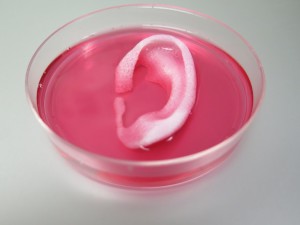
A completed ear structure printed with the Integrated Tissue-Organ Printing System. (Image credit: Credit: Wake Forest Institute for Regenerative Medicine)
Printing bones and cartilage could be the way of the future. Using specialized ‘bioprinters’, researchers have been able to “print” cells into layered patterns reconstructing human body parts. Current 3D printers are unable to create bone and cartilage with enough structural stability.
By combining bioprinters with biodegradable polymer materials researchers were able to “create” the cartilage of the external human ear as well as a jaw bone and skeletal muscle.
The authors note that more research and further development is needed before tissues from the bioprinter are suitable for human transplantation.
Original research paper published in Nature Biotechnology on February 15, 2015.
Names and affiliations of selected authors
